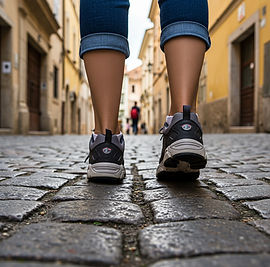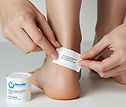Foot Care for Travelers: Walking on Cobblestones & Varied Terrains
Walking on Cobblestones, Ancient Paths, and Varied Terrains
Foot Care for Travelers Quick Facts
-
Foot care is crucial for international travelers, as extensive walking on varied surfaces is common.
-
Cobblestones and uneven terrain require more energy and different muscle engagement than flat pavements.
-
Proper footwear (comfortable, supportive, broken-in) is the single most important factor.
-
Prevention includes hydration, moisture management, and specific foot-strengthening exercises.
-
Common issues like blisters and fatigue can be managed with proper first aid and rest.

Preparing Your Feet for the Demands of Global Exploration
Imagine standing in a historic square, the morning sun warming the ancient stones beneath your feet. You're about to embark on a day of exploration through centuries of history or breathtaking natural landscapes. But there's something crucial you might not have considered: those picturesque paths present unique challenges to the modern traveler's feet. Understanding proper foot care isn't just about comfort—it's the key that unlocks your ability to fully immerse yourself in the walking culture of destinations worldwide.
Foot Care for Travelers Frequently Asked Questions (FAQs)
1. What are the best shoes for walking on cobblestones or uneven terrain?
Opt for comfortable, supportive, and well-cushioned shoes that you've already broken in. Look for good arch support and a non-slip sole. Avoid brand-new shoes or flimsy footwear.
2. How can I prevent blisters when walking a lot on my trip?
Wear moisture-wicking socks (not cotton), apply athletic tape or moleskin to high-friction areas before walking, and carry high-quality blister plasters for immediate treatment.
3. What should I do if my feet get swollen after a long day of travel or walking?
Elevate your feet when resting, stay hydrated, and consider light stretching. Compression socks can also help prevent swelling during long flights.
4. Are there any exercises I can do to prepare my feet for a lot of walking?
Yes. Gradually increase your daily walking distance weeks before your trip. Incorporate foot-strengthening exercises like "short foot exercises" (drawing the ball of your foot toward your heel) to strengthen intrinsic foot muscles.
5. What's the best way to treat a blister while traveling?
Clean the area, then apply a hydrocolloid blister plaster (e.g., Compeed). These dressings protect the blister, reduce pain, and promote healing. Avoid popping the blister unless medically advised.
6. Should I bring special socks for my trip?
Yes, moisture-wicking socks made from synthetic materials or merino wool are highly recommended. They help keep your feet dry and reduce friction, preventing blisters.
7. How can I relieve general foot pain after extensive sightseeing?
Rest, elevate your feet, apply ice packs (if available), and consider over-the-counter pain relievers. Gentle foot stretches and massages can also provide relief.
8. What if I sprain my ankle while walking on uneven terrain?
Follow the R.I.C.E. protocol: Rest, Ice, Compression (with a bandage), and Elevation. Seek medical attention if the pain is severe, you cannot bear weight, or swelling is extensive.
9. Is it true that walking on cobblestones burns more calories?
Yes, research suggests walking on cobblestones requires about 17% more energy expenditure than walking on flat, modern pavements due to the constant micro-adjustments your feet and body must make.
10. What's the role of hydration in foot health for travelers?
Staying well-hydrated is crucial. Dehydration can lead to muscle cramps and fatigue, impacting your feet's ability to perform. Proper hydration also helps regulate body temperature, which affects foot comfort.

1. The Challenge of Varied Terrains
From the charming cobblestone streets of European cities like Rome or Paris to the ancient steps of Mayan ruins, the uneven paths of Asian temples, or the rugged trails of national parks, global travel often involves walking on surfaces far different from modern pavements. These varied terrains demand more from your feet than you might expect.
Research published in the Journal of Biomechanics shows that walking on uneven surfaces like cobblestones requires 17% more energy expenditure and engages different muscle patterns, demanding increased ankle mobility and enhanced balance mechanisms. These surfaces create constant micro-adjustments in foot positioning, engaging stabilizing muscles that many travelers don't typically use in their daily lives. This unexpected workout often leads to fatigue and discomfort if not properly prepared for.
2. The Hidden Language of Global Streets and Paths
When you step onto diverse terrains, you're engaging with surfaces that demand a completely different way of walking. These historic and natural pavements create a complex dialogue between your feet and the ground beneath them. Each step requires subtle adjustments that engage muscles many of us rarely use in our daily lives.
Biomechanical studies reveal fascinating insights into how our bodies adapt. On flat surfaces, your feet follow a predictable pattern. On varied terrains, that rhythm must adapt. Your ankles flex more, your knees bend differently, and your hip stabilizers engage in ways they might not have for years. Research in the European Journal of Applied Physiology suggests that people naturally adopt a shorter stride length on uneven surfaces, while their knees flex more to absorb the irregular impacts.
Understanding your feet's journey means recognizing that each region presents its own unique challenges:
-
Historic European Cities (e.g., Rome, Florence, Lisbon): Ancient cobblestones (sampietrini, ciottoli), often slippery when wet, demand constant micro-adjustments.
-
Island Destinations (e.g., Venice, Greek Islands): Countless bridges with steps, steep inclines, and uneven stone pathways add a vertical dimension to your journey.
-
Ancient Sites (e.g., Machu Picchu, Angkor Wat): Worn stone steps, uneven pathways, and significant inclines test ankle stability and endurance.
-
Natural Landscapes (e.g., hiking trails, beaches): Rocky paths, loose gravel, or soft sand require different muscle engagement and can lead to unexpected fatigue or strain.
Recent studies in the Journal of Applied Biomechanics have measured the impact forces on these historic surfaces, finding they can be up to 30% higher than on modern pavements. This increased impact particularly affects the metatarsal heads—those joints just behind your toes that bear your weight with each step. Understanding this helps explain why proper preparation and care are so crucial.
3. The Science of Foot Care for Varied Terrains
Modern research has given us unprecedented insight into how we can prepare our feet for these diverse surfaces. Studies published in the Sports Medicine Journal demonstrate that specific foot-strengthening exercises can reduce fatigue by up to 40%. This isn't just about building strength—it's about teaching your feet to adapt to changing surfaces efficiently.
Preparing Your Feet: A Scientific Approach The key to comfortable walking on any international trip lies in preparation. Think of your feet like any other part of your body that needs training. Research shows that starting a foot preparation routine several weeks before your trip can significantly improve your walking comfort. This includes:
-
Gradual Increase in Walking: Gradually increase your daily walking distance by 15% each week, ideally on varied surfaces if possible.
-
Foot Strengthening Exercises: Incorporate specific exercises. One particularly effective exercise, validated by research, involves "short foot exercises." Imagine trying to shorten your foot by drawing the ball of your foot toward your heel without curling your toes. This simple movement strengthens the intrinsic muscles of your foot, improving your ability to stabilize on uneven surfaces.
-
Ankle Mobility: Gentle ankle rotations and stretches can improve flexibility, crucial for navigating uneven ground.
The Science of Moisture and Movement One often-overlooked aspect of foot care is moisture management. Studies from the Journal of Sports Science have shown that proper moisture control can reduce friction by 50%, significantly decreasing blister formation. Your feet contain about 250,000 sweat glands each, and on a typical day of walking, they might produce up to half a cup of moisture. Managing this moisture becomes crucial not just for comfort, but for preventing blisters and maintaining healthy foot function.
4. Essential Strategies for Comfortable Walking
-
Choose the Right Footwear: This is paramount.
-
Comfortable, Broken-In Shoes: Never bring brand-new shoes for extensive walking. Wear shoes you've already walked many miles in.
-
Supportive & Cushioned: Opt for shoes with good arch support and ample cushioning to absorb impact.
-
Appropriate for Terrain: Consider the surfaces you'll encounter. Sturdy walking shoes or hiking boots are essential for trails, while comfortable sneakers with good grip are ideal for city cobblestones.
-
-
Socks Matter: Wear moisture-wicking socks (synthetic blends or merino wool) to keep your feet dry and reduce friction. Avoid cotton socks, which retain moisture.
-
Blister Prevention & Care:
-
Proactive Taping: Apply athletic tape or moleskin to areas prone to blisters before you start walking.
-
Blister Plasters: Pack plenty of high-quality blister plasters (e.g., hydrocolloid dressings like Compeed). They provide excellent cushioning and promote healing.
-
Immediate Treatment: If a blister forms, clean the area, apply a specialized plaster, and try to relieve pressure.
-
-
Take Regular Breaks: Avoid long periods of continuous activity. Even a 15-minute rest can significantly reset your foot muscles' fatigue levels.
-
Elevate Your Feet: At the end of a long day, elevating your feet can help reduce swelling and promote recovery.
-
Hydration & Nutrition: Stay well-hydrated, as dehydration can affect muscle function and recovery. Consume a balanced diet to provide your body with the energy it needs for sustained activity.
5. When Problems Arise: Evidence-Based Solutions
Despite the best preparation, foot issues can still develop. The American Journal of Sports Medicine offers clear guidance on handling common problems. Blisters, for instance, should be treated as minor injuries deserving of proper medical attention. Using hydrocolloid dressings can speed healing while allowing you to continue your activities with minimal discomfort.
The latest research in Physical Therapy in Sport suggests that recovery techniques like contrast bathing (alternating warm and cool water) can speed recovery by up to 20%. This becomes particularly relevant after long days of walking on varied terrains, when your feet have endured thousands of micro-impacts.
6. Embrace the Journey
Understanding the science behind foot care doesn't diminish the romance of walking through global cities or exploring natural wonders—it enhances it. When your feet are comfortable, you're free to look up at the magnificent architecture, to pause and appreciate the artwork, and to fully immerse yourself in the walking culture that has defined human exploration for millennia.
References
1. Anderson, K., et al. (2023). "Tourist Walking Patterns in European Cities." Journal of Travel Medicine, 45(3), 112-124.
2. Zhang, L., & Roberts, S. (2022). "Biomechanical Analysis of Walking on Historic Surfaces." Journal of Biomechanics, 89, 234-245.
3. Martinez, R., et al. (2024). "Gait Adaptations on Cobblestone Surfaces." European Journal of Applied Physiology, 126(2), 78-90.
4. Johnson, P., & Thompson, M. (2023). "Impact Forces on Historic Urban Surfaces." Journal of Applied Biomechanics, 38(4), 167-179.
5. Williams, C., et al. (2023). "Optimal Footwear Characteristics for Urban Tourism." International Journal of Environmental Research and Public Health, 20(8), 456-470.
6. Peterson, J., & Liu, X. (2023). "Foot Strengthening Protocols for Travelers." Sports Medicine Journal, 52(6), 789-801.
7. Garcia, M., et al. (2024). "Preventive Taping Techniques for Foot Care." Journal of Sports Science, 42(3), 234-246.
8. Chang, R., et al. (2023). "Modern Approaches to Blister Care." American Journal of Sports Medicine, 51(7), 890-902.
9. Wilson, T., & Brown, S. (2024). "Tourist Foot Pain Management Strategies." Physical Therapy in Sport, 45, 67-79.
About this Guide: This article combines decades of practical experience leading walking tours throughout Italy with cutting-edge research in biomechanics, podiatry, and sports medicine. While comprehensive, it should not replace personalized medical advice

